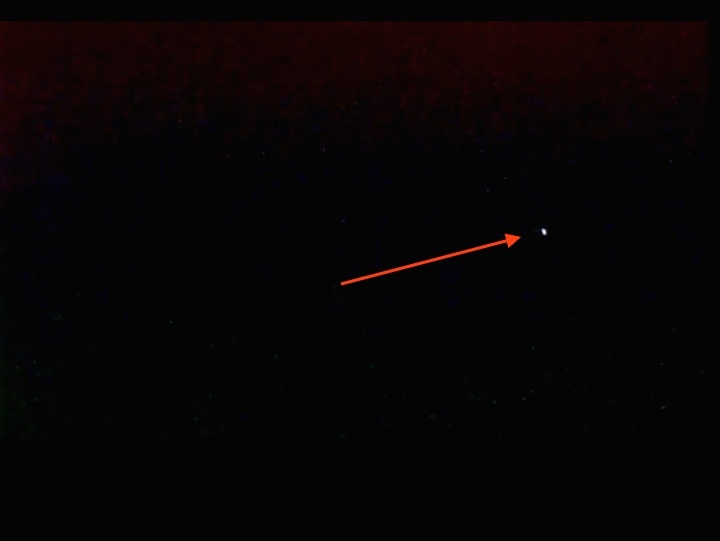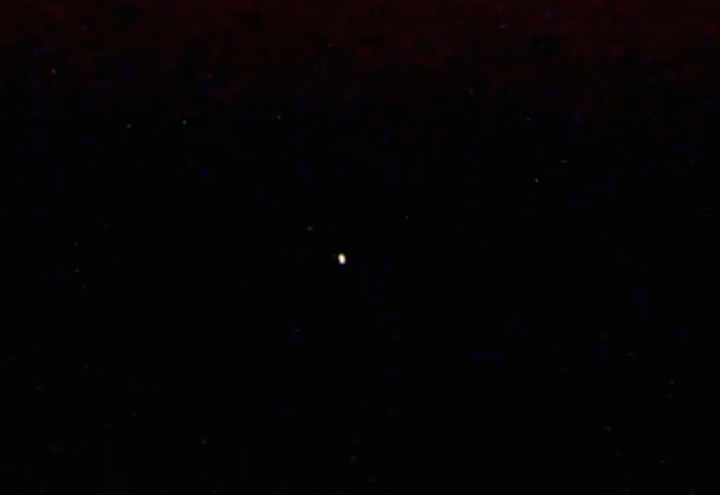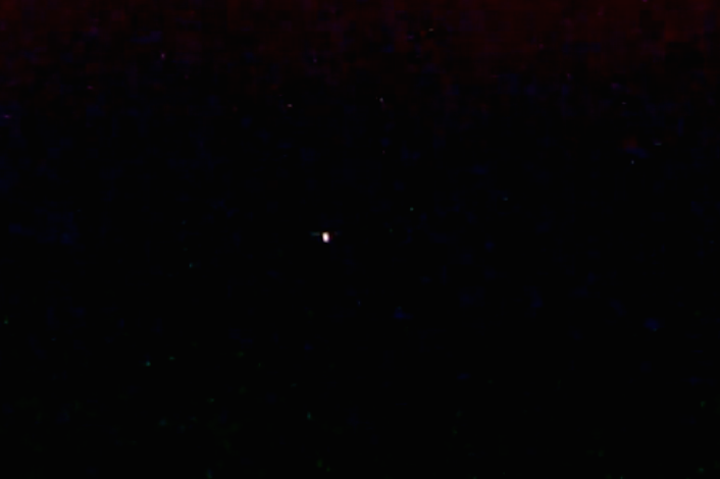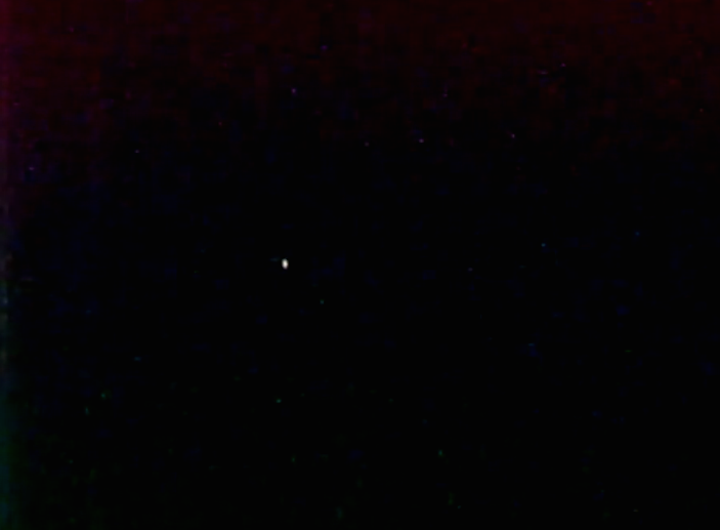
Immer wieder erreichen uns Meldungen von UFO´s welche im Livestream der ISS zufällig gesehen werden und für Rätselraten sorgen. So auch aktueller Fall von Herrn M.K.:
18.11.2017
Sehr geehrte Damen und Herren,
Ich habe eben den ISS Livestream angeschaut und miteinmal flog etwas von rechts nach links durch das Bild ich habe
sofort mehrere Screenshots gemacht bis das Objekt aus dem Bild war, es flog recht schnell und leuchtete. Will nicht
sofort von einem UFO sprechen aber in dem Fall ist es ein Unbekanntes Flugobjekt. Vielleicht können Sie mir
weiterhelfen.
Als Anhang sende ich Ihnen die Screenshots.




Auf den ISS-Livestream-Screenshots sieht man ein helles Pünktchen. Schlussendlich kann dieses
Pünktchen alles sein, aber wir gehen stark davon aus, es sich hierbei um abgelöste Eispartikel oder Lackteilchen handelt welche sich an der ISS ständig ablösen. Diese Eispartikel entstehen durch Ablassen von Abwasser an der ISS, da das Wasser versprüht wird und sich sofort an der Außenhaut als Eis absetzt. Wenn leichte Erschütterungen dann in der ISS erfolgen durch Steuerungsdüsen der Soyuz-Raumschiffe zum Anhaben der Umlaufbahn oder aber durch die starke Anstrahlung der Sonne, lösen sich diese Eispartikel und werden von der Kamera erfasst. Da sie recht nah an der Kamera sind entsteht der Eindruck von Schnelligkeit und von weit draußen.
Wenn Sie einmal den Live-Start einer Rakete verfolgen, werden Sie solche "schnellen Eispartikel" beim Ablösen im Orbit auch sehen können wenn sogenannte Opferkameras die Abtrennung der letzten Stufe vom Satelliten zeigen.
-
Da die NASA ständig mit solchen Anfragen konfrontiert wird, gibt es auch von NASA genügend Statements dazu, hierzu zählt auch James Oberg welcher sich speziell den Meldungen aus der Raumfahrt annimmt:
...
How One Man Has Explained Almost Every Internet UFO Theory
It’s mostly a bunch of space dandruff, he says.

The Space Shuttle Endeavor, silhouetted on the mesosphere. (Photo: NASA/Public Domain)
IF YOU HAPPEN TO FREQUENT the more UFO-happy corners of the internet, you’ll see a lot of weird things: exploding blue lights high above the horizon, eerie white specks floating around the Space Shuttle, and something called “space dandruff”.
If you don’t believe your eyes, try scrolling down to the comments. You might find, sprinkled among them, the strangest sight of all: former NASA employee James Oberg, calmly explaining what is really going on.
Oberg worked at Mission Control in the late ’90s, and then became a space journalist and historian. A few years ago, he picked up a new hobby: taking UFOs seriously. Unlike other debunkers, Oberg is less into dismissing theories offhand (an activity he calls “stomping on dormice”) and more interested in figuring out exactly why people react so strongly to outer space images and footage.
To do this, he has combed through decades of supposed UFO sightings, reading eyewitness testimony and cross-referencing it with mission logs. In the process, he’s come to an interesting conclusion: human senses, evolved in and trained on (relatively) slow-moving objects, certain light conditions, and an atmosphere, get thrown into a tizzy when those conditions change. “Our sensory system is functioning absolutely perfectly for Earth conditions,” says Oberg. “But we’re still a local civilization. Moving beyond our neighborhood has been visually confusing.”
Here are three outer space phenomena that Oberg says tend to bamboozle the human eye, and the truth behind them.
1. Super-High Plumes
Last November 7th, Californians who happened to be out stargazing got a little more than they bargained for. Around 6 p.m., a strange object began shooting across the sky, drawing mass attention. Then, before their eyes of a freaked-out populace, it erupted, growing what looked like a huge, bright tail of blue flame. The sight sent the whole state into a frenzy. Even Julien Solomita and Jenna Marbles, rapid-talking YouTube stars whose footage of the event has been viewed nearly 10 million times, stayed quiet for several minutes as the weird thing passed overhead.
The New York Times was also on it, taking the opportunity to ask experts why people are so eager to pin such sightings on aliens. “Extraterrestrials are like deities for atheists,” author Michael Shermer explained at the time. “It’s almost a replacement for mainstream religion.”
But you don’t really need a spiritual void in order to jump to conclusions about an expanding cone of blue light high-tailing it across the sky. You just need eyes that grew up on Earth. As Oberg explains, that giant blue blast was actually a plume—a swarm of particles emitted by a rocket thruster as it shoots through space.

A more familiar contrail plume, emitted by an Air Force jet. (Photo: David Shankbone/CC BY-SA 3.0)
We’re used to seeing bulbous smoke plumes, or the skinny vapor trails left by planes. Rocket plumes, though, look and act much differently. Because they’re unencumbered by air, they spread out into wide-angled cones. Some of the particles even ricochet off the rocket itself, and end up in front of or alongside it, expanding the plume further. Most importantly, if the rocket is high enough above us, it might be in full sunlight, even if we, its observers, are still in the dark. This effect is most pronounced at twilight. From Earth, and to our untrained eyes, the object looks like it’s shooting fire—but it’s really just a plume, enjoying some solar backlight.
This particular plume was from a Navy test missile. Others have shown up in Russia, Australia, and the Canary Islands, garnering similar responses. “There were thousands of people who were absolutely processing their visual stimuli correctly if [the plume] was a mile away or ten miles away,” says Oberg of the California event. “But it was 300 miles away, up in space and sunlit, which never occurred to them, because this is not something within the normal range of human experience.”
2. Space Dandruff
Many NASA space shuttles went up with backward-facing cameras, which researchers used to study lightning pulses and other phenomena. Footage from these cameras, much of which can be found on YouTube, largely shows grainy views of the Earth from above. Sometimes, though, mysterious white spots will pop up and “dance” in front of the camera. (In the video above, which shows the so-called “Zig-Zag UFO” from STS-48, these spots are best visible starting around 3 minutes in.) Viewers have speculated that these lights are anything from “Star Wars testing” to rogue satellites to alien crafts.
But as Oberg points out, such theories require an Earthly frame of mind, in which the viewer is standing still. In reality, the space shuttle is hurtling at around 17,500 miles per hour. A Soviet rocket or alien craft at cross-orbits with the shuttle would only be visible on camera for a split second as it zipped by, like a car going the other direction on the highway. Because of this, anything that stays alongside a shuttle long enough to remain in a camera’s field of view almost definitely comes from that shuttle. The particular dots can’t be precisely identified—after all, they’re just dots—but they are almost certainly ice flakes, fragments of insulation, or other bits and pieces that have peeled off the shuttle itself and are now floating alongside it. Oberg calls this stuff “space dandruff.”
If there’s enough dandruff out there, watching it can even be a beautiful experience. When Oberg worked at NASA, he and his coworkers would sometimes take breaks to watch these videos for fun. “The earth’s still dark, the sky is full of stars, and these little snowflakes are playing out there, tumbling,” he remembers.
3. Twilight Shadowing
While poring over similar videos recorded by various space shuttles, Oberg noticed that all the most convincing ones had something in common. “They tend to occur at a very special time every orbit, when the shuttle has just come up out of the Earth’s shadow and is now bathed in sunlight,” he says. “The camera is pointed back toward the receding horizon, and stuff suddenly appears, like it’s coming up from behind the horizon, or behind a cloud.” You can see this in the above video, from the Space Shuttle Columbia’s November 1996 mission.
Extraterrestrial buffs are particularly into the part around five minutes in, when small specks of light blip in and out of sight, eventually forming a roughly circular shape.
Even if you happen to know that most shuttle-adjacent objects are just dandruff, their sudden appearance and disappearance might be cause for confusion. But as Oberg explains, the objects aren’t actually jumping through a wormhole, or rising suddenly over the horizon—they’re just moving in and out of the shuttle’s shadow.
On Earth, when an object blocks sunlight from reaching something, like the ground, a wall, another object, it casts a shadow on its surface. Since space lacks such a surface, the Shuttle’s shadow is invisible—until, suddenly, it swallows up some dandruff, and then spits it back out. Oberg calls this “twilight shadowing.” “You can see things floating out of it and floating into sunlight,” says Oberg. “They look like stuff that’s coming up from beneath the clouds, or from beyond the edge of the Earth.” Really, though, they’re just coming back into our line of vision.

The Space Shuttle Discovery, casting no shadow. (Photo: NASA/Public Domain)
These various types of visibility, and how we interpret them, are endlessly fascinating to Oberg. Their very weirdness helps us remember that we’re dealing with an environment that’s very strange to us—even stranger, maybe, than the ideas that propagate in an Internet rabbit hole. “Everyone on YouTube just calls each other morons or sheeple,” says Oberg. “But really it’s just that out there, your visual assumptions are no longer valid.” Once you remember that, he says, “there’s often an epiphany, where you realize, wait a second—this is outer fucking space.”
Quelle: Atlas Obscura
